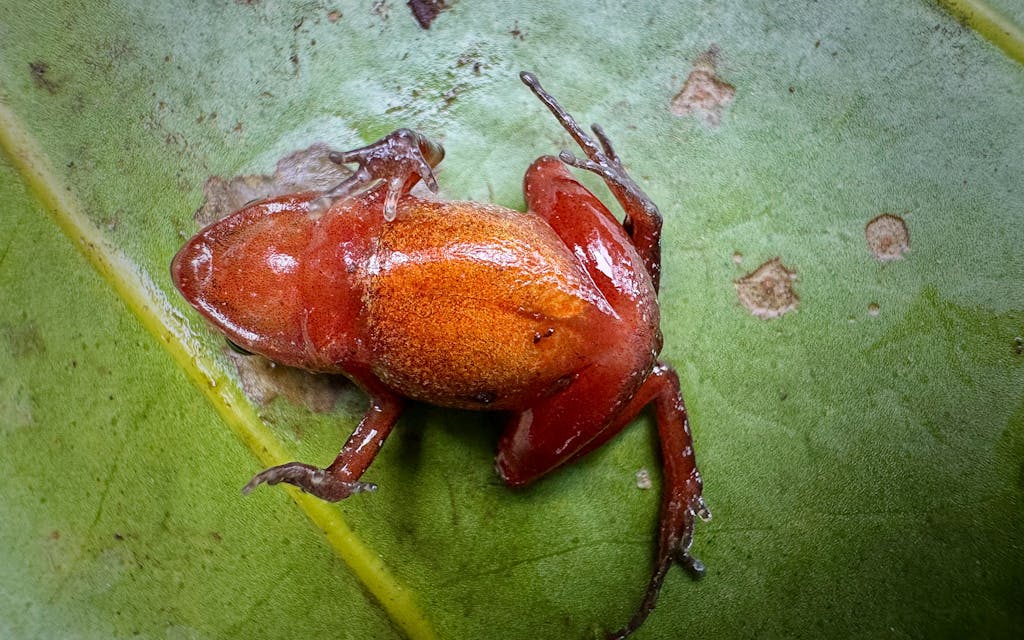WHO: University of Texas at El Paso scientists Eli Greenbaum, Michael Harvey, and Matthew L. Brady, along with Congolese researchers Chifundera Kusamba, Robert Kizungu Byamana, Chance Bahati Muhigirwa, Mwenebatu Aristote, and Wandege Muninga.
WHAT: A six-week expedition to the Itombwe Mountains in the Democratic Republic of Congo, during which the joint Texan-Congolese team discovered two rare species—a frog and a bird—that had not been spotted in the wild in decades.
WHY IT’S SO GREAT: Both species were feared to be extinct. The red-bellied squeaker frog, Arthroleptis hematogaster, had not been seen since the 1950s, and the last-recorded sighting of the yellow-crested helmetshrike, Prionops alberti, was almost two decades ago. During their six-week expedition through the cloud forests on the mountain slopes, researchers were able not only to photograph each species, but to study their behaviors over the course of days and weeks.
The team brought back a wealth of new knowledge about these little-known creatures. “Because we spent about a week of our six-week expedition in the helmetstrike’s habitat observing the bird, we got the first publicly available audio recordings, and we know more about what they sound like,” says Harvey, one of the two UTEP ornithologists on the trek. “We got photos of live birds, and previously they were just basically described from specimens of dead birds. We got to observe them behaving and doing things in the forest, so we made some notes on their behavior and their ecology.” The helmetshrike is a gregarious, noisy stunner that gets its name from the vibrant cap of yellow feathers atop its head. Spotting one was a wonderful surprise for the research team. “We had it in the back of our minds [that we might see one], but it wasn’t one of our main targets,” says Harvey. “We just happened across it serendipitously.”
Listen to the call of the yellow-crested helmetshrike:
Spotting the bird may have been unexpected, but its existence was not as surprising as you might think. The fact that the helmetstrike hadn’t been seen or documented in decades didn’t necessarily mean it was extinct. “ ‘Unknown to Western science’ isn’t the same as being lost,” says Harvey. “There are parts of the world that are really poorly known that biologists and bird watchers don’t get into,” he added, and this remote mountain region in Central Africa is one of them. Just making it to their research site required a lengthy, Indiana Jones–style journey. “It took us two weeks just to get to the place where we saw the bird, traveling in four-wheel-drive vehicles, and then on dirt bikes and then on foot for over a week.”
The team was guided by researchers at the Democratic Republic of Congo’s Centre de Recherche en Sciences Naturelles, with whom UTEP herpetologist Eli Greenbaum has coordinated several expeditions over the years. “I would not have a field program in Africa if it were not at the invitation of the amazing scientists at this research center,” says Greenbaum. He was first drawn to that part of the world, a “biodiversity hotspot,” when he was in grad school in the early aughts.
As soon as Greenbaum and the other herpetologists arrived in the cloud forest, they began scanning the environment. Persistence and diligence were key to the search. “We looked at the ground, at the leaf litter. We looked at waist height, on the plants. We searched during the day. We searched at night. We searched when it’s raining. We searched when it’s dry. And these frogs just started popping up,” recalls Greenbaum.

The red-bellied squeaker frog was first discovered by Belgian scientists after the Second World War, when the Congo was still under colonial rule, and it hadn’t been seen by Western scientists since the 1950s. But Greenbaum and the rest of the team found a number of them. “I think they’re relatively common—it’s just that nobody had been into this really remote area where they occur for a really long time.”
The discovery of these two species opens up a host of exciting scientific possibilities. “Whenever you find a rare species like this and you’re able to get a genetic sample and photographs for the first time, you’re then in a position to compare it to other frogs in that same group. Do they match something that’s been missing for decades like this? Or are they, in fact, a new species to science?” says Greenbaum. “Finding this thing that the scientific community doesn’t know about is a prerequisite for implementing conservation priorities. In other words, we can’t conserve something if we don’t know about it.”
And there’s a lot they still don’t know. One morning, Greenbaum was sipping coffee in his tent, still in his pajamas, when a Congolese staffer alerted him to an exceedingly rare snake crawling by outside. “I jumped out barefoot into the mud to catch the thing,” he told KUT. He still isn’t sure what species it is, or if it might even be a new one, but he took a DNA sample to process back in the lab. Results are pending.
Harvey hopes that the team’s discovery will bring attention to this underappreciated region and its magnificent flora and fauna. “This area is one of the most unique places in the world that has a whole bunch of endemic species, species that only live in that area,” he says. “Just raising awareness about the importance of this area for biological diversity, I think, will get people on board with caring and wanting to protect that diversity.”
- More About:
- Critters
- Best Thing in Texas
- Wildlife
- El Paso








